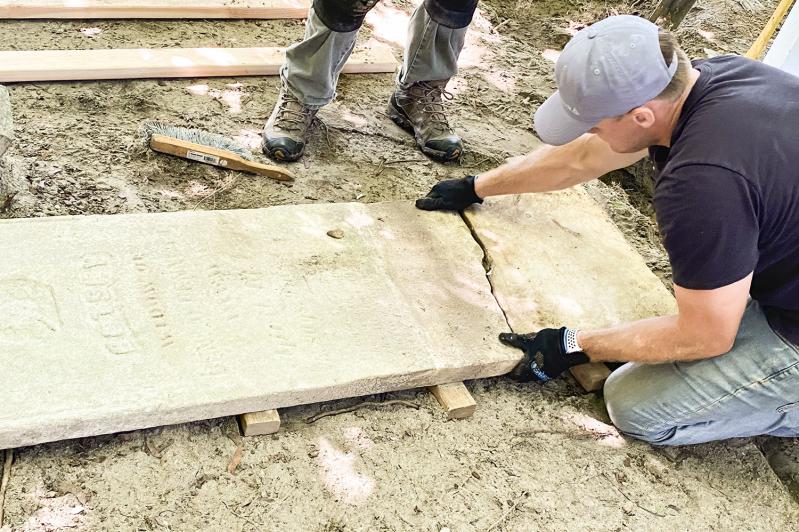One quick way to know if a burial ground from the colonial era has been disturbed, according to Zach Studenroth, is if the front of a headstone does not face west.
“Throughout the 17 and 18 hundreds, they adhered to a Christian belief that you want to lay the deceased on a west-to-east axis with the head to the west,” Mr. Studenroth, a founder of the Burying Ground Preservation Group, said in a phone call. “That way, they could sit up, witness the miracle of the Christ rising in the east in his second coming, and, hopefully, go along.”
Last week, East Hampton Town completed restoration on two of its smaller colonial-era cemeteries: The Benjamin Bennett Cemetery on Three Mile Harbor Road, and the Lewis Edwards Cemetery on Springs-Fireplace Road.
While the town boasts some large, well-known, historic cemeteries, less visible are the smaller family cemeteries dotted throughout the area. Some have just a single headstone. They’re visited infrequently, the families buried are older, and a handful have fallen into disrepair.
The location of these small cemeteries is directly tied to the town’s history, Mr. Studenroth said. In the early days, when the town was rural, farms were scattered several miles north of East Hampton Village, many in Springs. Early settlers were reluctant to bury their family members far from their homesteads, and instead developed modest family plots. Hence, cemetery names often reflect the family buried there.
Cemeteries, large or small, are a line item on the town budget. Most of the money is used for maintenance, like cutting the grass or fixing fences (New York State Cemetery Law requires that abandoned cemeteries must be fenced). Councilman David Lys, who is spearheading the restoration plan, said the budget is small, roughly $18,000 a year.
“In my initial movement to choose which cemeteries to prioritize, I was trying to gain support to continue the work, so I tried to pick cemeteries that the town has complete access to [some are on private lands] that are also in the public eye,” he said. “It’s on a road or off a popular hiking trail. That’s why we took on the Hedges-Parsons Cemetery in 2020.” That cemetery is near the Springs School, and “Six hundred parents a day got to see a cemetery restored.”
A 2009 report titled “State of East Hampton Cemeteries,” compiled by Eileen Roaman-Catalano and Richard Whalen, a local lawyer, for the town’s Nature Preserve Committee, inventoried the town’s cemeteries (there are about 45) and documented the location, condition, and maintenance needs of each. Although 15 years old, it’s still the main cemetery-related document used by the town.
For example, it notes of the Benjamin Bennett Cemetery that it has four headstones and four footstones and was active from 1860-1885. It also provides this nugget: “Some local lore/speculation is that there are graves by the next-door neighbor ‘Fields’ shed and the Fields are not interested in that being known.”
“That document serves as a checklist for us,” said Mr. Studenroth. “David [Lys] has very steadily been chipping away at these smaller rural sites. These two are typical of these widely scattered family burial grounds laid out in the 19th century on private property.”
Ms. Roaman-Catalano died young, in 2013. “Eileen was a close friend,” said Councilman Lys. “I feel very connected in her spirit to move the cemetery projects forward. Personally, I hope she’s happy we’re doing this. The cemeteries are always going to be there, and it’s up to the town to maintain them. The last things we know about some of these founding families is what’s written on their tombstones.”
There are two main aspects to cemetery restoration. The easier part is cleaning the stones of lichens and other “surface biogrowth” that can render the words illegible. A solution sprayed on the stones kills the vegetation without damaging them, Mr. Studenroth said.
If a stone is broken or chipped, perhaps by a fallen tree limb, or if it has toppled over because of frost heave, a more specialized repair, performed by Joel Snodgrass, another founder of the Burying Ground Preservation Group, is needed. In the Benjamin Bennett Cemetery, for example. one of the stones was badly tilted and another was broken. Mr. Snodgrass excavated the marble that remained below ground (typically just two-thirds of a headstone is visible), reattached the aboveground pieces, and reset the stone so that it was perfectly plumb.
The 2009 report suggested legislation that would make defacing cemeteries an enforceable crime, but Councilman Lys said that while no such legislation exists, vandalism hasn’t been a problem. Instead, in the last decade, neighborhoods close to these small plots have become cemetery-proud, often watching over and maintaining them beyond the town’s efforts. Mr. Lys is more interested in working on legislation that would give each burial ground its own Suffolk County tax map number, making it easier to recognize its boundary. At present, no zoning laws exist regarding cemeteries, and the 2009 report reports instances where pool sheds or other structures directly abut a burial ground.
There are no other cemetery restoration projects in the works right now, but Mr. Lys noted that the town has applied for a competitive $600,000 state grant that would provide for the restoration of the South End Cemetery at Town Pond, likely a multi-year project. (South End Cemetery is within East Hampton Village boundaries, but is owned by the town.)
“That would be a large project, to restore the fence, the stones, and to do a tree survey,” he said. The town probably will not hear back about the grant until the end of the year.




